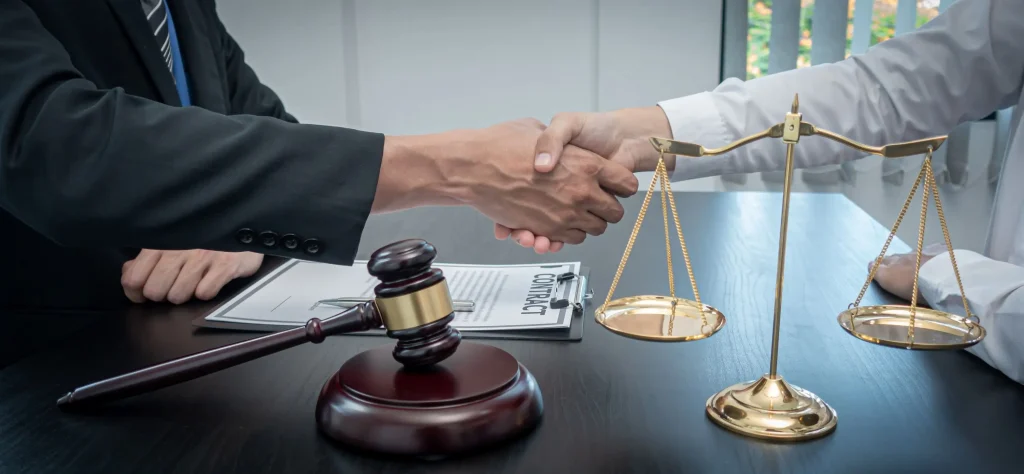Overview of ‘No Fault’ States and Insurance Laws
In the U.S., car insurance rules differ between “no fault” and “at-fault” states. Arizona operates under a fault-based system, affecting how claims and compensation are handled after accidents.
Arizona Fault Insurance Laws
Arizona is an “at-fault” state. After a car accident, the person found responsible for the accident is liable for damages. Their insurance typically covers the costs. This includes vehicle repairs, medical bills, and other losses.
If you’re involved in an accident in Arizona, you have three main options. You can file a claim with your own insurance, contact the at-fault driver’s insurance, or sue the at-fault driver.
Arizona requires drivers to carry minimum liability insurance. This ensures funds are available to pay for any damages you cause to others.
Hiring an Arizona Attorney
After a personal injury, things can quickly become overwhelming. Victims are often faced with unexpected challenges like expensive medical bills, navigating insurance claims, and seeking medical attention.
Juggling all of this while keeping up with daily life is tough! Hiring a lawyer can help reduce some of this pressure. Your attorney works for you and prioritizes your needs over those of the insurance companies.
It’s comforting to have someone on your side during difficult times. If you’ve been injured in a minor car accident or a more serious situation, feel free to contact the Law Gang.
Our office assists all types of clients involving all kinds of different personal injury claims like:
- Bus accidents
- Small fender benders while backing up
- Retail – Department store accidents
You don’t have to go through this alone.

‘No Fault’ & At-Fault States
In “no fault” states, each driver’s insurance covers their own damages and medical expenses regardless of who caused the accident. This limits the ability to sue for additional damages unless certain criteria are met.
Conversely, in “at-fault” states like Arizona, determining who caused the accident is crucial. The at-fault driver’s insurance must pay for the damages. This can lead to lawsuits if parties disagree on who is responsible.
Understanding these differences helps you navigate how claims and payouts work based on your location.
Auto accidents can happen on type and size of road in Arizona from the big freeways like Interstate 40 to the small surface roads such as:
Determining Liability
In Arizona, liability for motor vehicle accidents is influenced by several factors, including the comparative negligence rule and shared fault. Understanding who is responsible and how insurance plays a role is crucial.
Role of Comparative Negligence
Arizona uses a comparative negligence system. This means that fault can be shared between drivers in an accident. Each party involved may be assigned a percentage of the blame.
For example, if you are 20% at fault, your compensation will be reduced by that percentage.
This approach allows you to recover damages even if you are partially at fault. Courts determine the percentage of fault based on evidence, witness statements, and accident reports.
It is important to note that a skilled legal representative can help argue your side effectively to ensure a fair outcome.
Consequences of Shared Fault
Shared fault affects how damages are awarded. If multiple parties are at fault, the compensation each party receives is adjusted according to their share of fault.
Say you’re in an accident and found to be 30% responsible; you could still receive 70% of the damages.
Insurance companies also assess shared fault. They have adjusters who review the incident to assign fault percentages.
This impacts your insurance premiums and the amount you may recover. You might face increased premiums, even if only partially at fault.

Responsibility for Car Accidents
Determining who is responsible for a car accident involves several elements. These include traffic laws, eyewitness accounts, and accident scene evidence.
The driver who violates a traffic law, like running a red light, is generally considered at fault.
Sometimes, vehicle owners might be liable even if they weren’t driving. This can happen if they let an unfit driver use their car.
Responsibility for damages is typically handled by your insurance, which covers costs up to your policy limit.
Understanding these basics helps navigate liability claims more smoothly and prepares you for potential legal processes.
Insurance Coverage and Payments
In Arizona, understanding how insurance works after a car accident is crucial. Learning about insurance payment responsibilities and the differences between car and driver insurance in Arizona can help you navigate this process.
Insurance Vs Out-of-Pocket Expenses
When an accident occurs, determining who pays for damages is important. Typically, the at-fault driver’s insurance company is responsible for covering damages.
This means if you are not at fault, your expenses should be covered by the other driver’s insurance.
In some cases, you might still face expenses if your own insurance coverage, like uninsured motorist coverage, needs to be used. It’s important to know your policy details to avoid unexpected costs.
If you’re at fault, your insurance will cover the other party’s damages up to your policy limits. Any costs exceeding these limits may require out-of-pocket payment.
Carefully reviewing and understanding your auto insurance policy can prevent surprises.
Dedicated to personal injury claims, The Law Gang serves the entire state of Arizona. This state features a blend of major urban centers, college towns, and rural regions. If you’ve been injured in any of these areas, contact us today.
- Glendale
- Apache Junction
- Cave Creek

Vehicle vs. Driver Insurance
In Arizona, insurance is specific to the vehicle rather than the driver. That means if someone else drives your car and gets into an accident, your car insurance is likely the first to cover any damages.
This could mean you are liable for accidents even if you’re not the one driving. However, if the driver’s own insurance is needed, it might act as secondary coverage, depending on the circumstances and the policies involved.
Always know who is driving your car and ensure they are covered under your policy where applicable. This can help avoid confusion and potential financial burdens should an accident occur.
Legal Steps
If you’re in a car accident in Arizona and it’s not your fault, certain legal steps can help protect your rights.
Understanding immediate actions to take and knowing the time limits for filing a lawsuit are important considerations.
In Arizona’s many counties, The Law Gang provides comprehensive services for personal injury claims, from auto accidents to slip and falls to wrongful death claims, including:
- Pima
- Yuma
- Apache
Immediate Actions
Right after a car accident, it’s essential to stay calm. Check for injuries and call 911 if anyone is hurt. Always contact the police to report the accident.
Police reports can be crucial for insurance claims and any legal proceedings.
Exchange information with the other driver. This includes names, contact information, and insurance details. Take pictures of the accident scene, your vehicle, the other vehicle, and any visible damages.
Gather witness statements if possible. Seek medical attention even if you feel okay. Some injuries may not be immediately evident.
Notify your insurance company soon after the accident. They will guide you on the next steps and inform you about your coverage and rights.
Time Limits for Filing
In Arizona, if you plan to file a lawsuit after a car accident, you have a two-year statute of limitations. This means you must file a lawsuit within two years from the date of the accident.
If someone dies because of an accident, the two-year limit applies for wrongful death claims starting from the date of death.
Failing to file within this period usually means losing the right to pursue legal action. Always consider consulting with an attorney to understand your rights and any exceptions to the rule.
Vehicle Ownership and Liability
In Arizona, the registered owner of a vehicle can face liability issues even if they were not the driver at the time of an accident.
Additionally, if someone not listed on your insurance gets into an accident with your car, there are specific rules on who is responsible.
Liability of the Owner When Not Driving
If someone else drives your car and causes an accident, you might still face some liability. This is because you gave them permission to use your vehicle.
Arizona follows the “vicarious liability” principle, which means the car owner can be responsible for the driver’s actions.
There are some exceptions. For instance, if the car was stolen, you aren’t liable for damages. However, if the driver had a poor driving record or other red flags, your liability might increase.
It’s vital to be cautious when letting others use your car.
Non-Listed Drivers
In Arizona, car insurance generally follows the car, not the driver. If a person not listed on your insurance is driving your car and gets into an accident, your insurance typically covers the damages.
However, this can depend on your policy’s terms.
Having a comprehensive insurance policy is important. Some insurers might deny a claim if they find out that the driver wasn’t listed.
Moreover, if damages exceed your policy limits, you could still be financially responsible. Always check with your insurance company to know precisely what your policy covers.






